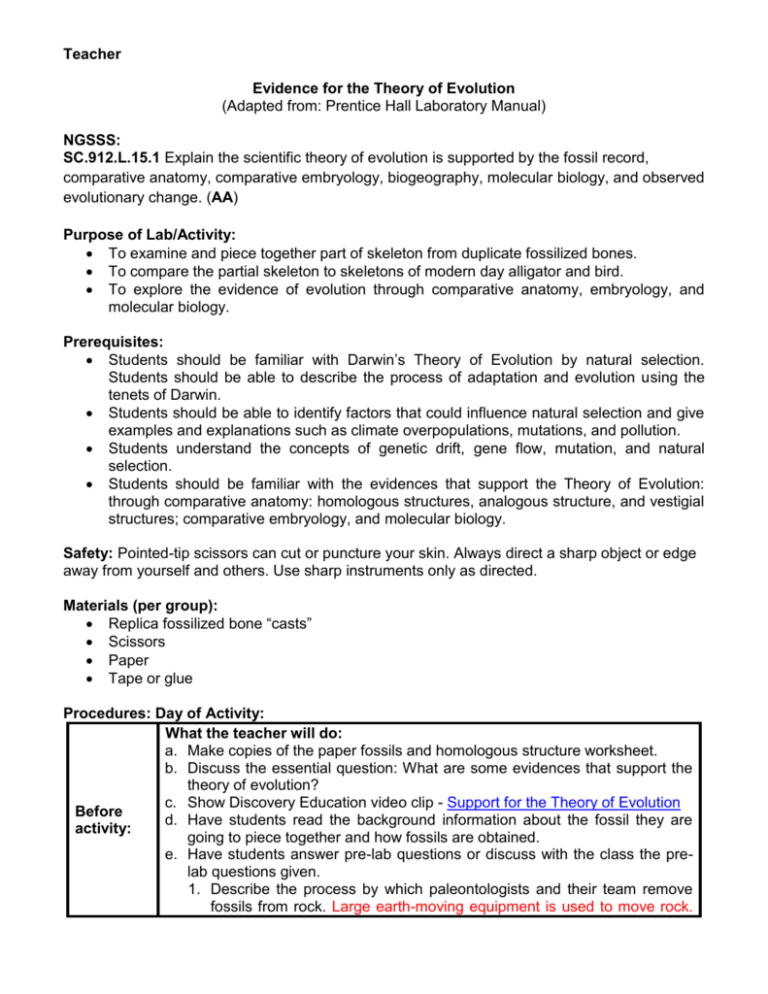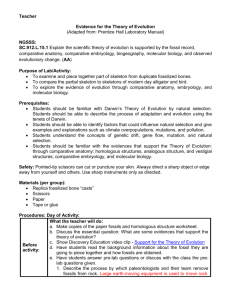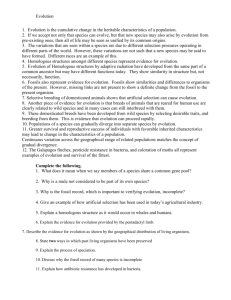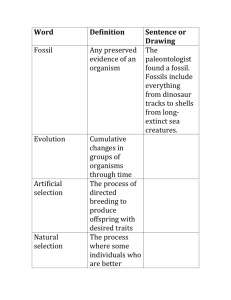Evidence Theory of Evolution(CER)
advertisement

Teacher Evidence for the Theory of Evolution (Adapted from: Prentice Hall Laboratory Manual) NGSSS: SC.912.L.15.1 Explain the scientific theory of evolution is supported by the fossil record, comparative anatomy, comparative embryology, biogeography, molecular biology, and observed evolutionary change. (AA) Purpose of Lab/Activity: To examine and piece together part of skeleton from duplicate fossilized bones. To compare the partial skeleton to skeletons of modern day alligator and bird. To explore the evidence of evolution through comparative anatomy, embryology, and molecular biology. Prerequisites: Students should be familiar with Darwin’s Theory of Evolution by natural selection. Students should be able to describe the process of adaptation and evolution using the tenets of Darwin. Students should be able to identify factors that could influence natural selection and give examples and explanations such as climate overpopulations, mutations, and pollution. Students understand the concepts of genetic drift, gene flow, mutation, and natural selection. Students should be familiar with the evidences that support the Theory of Evolution: through comparative anatomy: homologous structures, analogous structure, and vestigial structures; comparative embryology, and molecular biology. Safety: Pointed-tip scissors can cut or puncture your skin. Always direct a sharp object or edge away from yourself and others. Use sharp instruments only as directed. Materials (per group): Replica fossilized bone “casts” Scissors Paper Tape or glue Procedures: Day of Activity: What the teacher will do: a. Make copies of the paper fossils and homologous structure worksheet. b. Discuss the essential question: What are some evidences that support the theory of evolution? c. Show Discovery Education video clip - Support for the Theory of Evolution Before d. Have students read the background information about the fossil they are activity: going to piece together and how fossils are obtained. e. Have students answer pre-lab questions or discuss with the class the prelab questions given. 1. Describe the process by which paleontologists and their team remove fossils from rock. Large earth-moving equipment is used to move rock. Teacher During activity: After activity: Then smaller hand equipment is used to remove bits of rock and dirt from the fossils. The fossils are covered in plastic wrap or foil to protect them. Then they are covered with plaster. A paleontologist works under the fossils to remove them from the rock. The fossil block is then removed from the earth, tipped over, and plaster is applied to the bottom side. The fossils are now ready to transport to a laboratory for study. 2. Fossil skeletons are rarely complete. How do you think casts and collaboration help paleontologists create more complex skeletal models? If a scientist at one lab or museum is missing a key piece of a skeleton, the scientist can request a cast of the missing bone from a colleague. 3. What role do you think inferences play in the work of a paleontologist? Answers may vary. When certain bones are not available for observation, the paleontologist will have to infer what the bone may have looked like based on other bone sample and the homologous bone in similar species. What the teacher will do: a. To make the activity more realistic and challenging, cut out the bone pieces and place them in envelopes. Randomly remove one bone from each envelope and place it in a different envelope. Lab groups will then have to collaborate to get all the pieces that they need. b. Use comparative anatomy to help guide them in the placement of other bones. Activity takes approximately 20 minutes for Part A. c. Have students check off which features you observe in each skeleton. Activity should take approximately 15 minutes. d. Activity C: color the homologous structures the same color according to each species. Approximately 15 minutes. e. Activities D-G can be continued the next day. Covers analogous structures, vestigial structures, and comparative embryology. f. Expected results of piecing together Deinonychus bones with only one limb of each. What the teacher will do: a. Discuss with the class how they think each contributes to the evidence to the theory of evolution. Student answers should include that each branch provides proof of each evolution of the species. Teacher b. Discuss the molecular evidence that contributes also to the theory of evolution. With the advancement of DNA technology, scientists now rely more upon comparisons of protein structure, amino acid sequences, and DNA sequences to determine evolutionary relationships. The more closely related the species, the more similar their genetic material will be. c. Discuss how biogeography also contributes to the theory of evolution. Biogeography is the study of the distribution of life forms over geographical areas. Biogeography not only provides significant inferential evidence for evolution and common descent, but it also provides what creationists like to deny is possible in evolution: testable predictions. Biogeography is split into two areas: ecological biogeography which is concerned with current distribution patterns and historical biogeography which is concerned with long-term and large-scale distributions. Extension: Gizmo: Evolution – Natural Selection and Artificial Selection, Mutation and Selection Teacher Evidence for the Theory of Evolution (Adapted from: Prentice Hall Laboratory Manual) NGSSS: SC.912.L.15.1 Explain the scientific theory of evolution is supported by the fossil record, comparative anatomy, comparative embryology, biogeography, molecular biology, and observed evolutionary change. (AA) Background Information: Evolution is not just a historical process; it is occurring at this moment. Populations constantly adapt in response to changes in their environment and thereby accumulate changes in the genes that are available to the species through its gene pool. In today's lab you will explore some of the evidence for evolution and will examine a few of the mechanisms through which evolution acts. In this laboratory you will review some of the classical examples used as evidence for evolution. Keep in mind that the support goes far beyond these simplistic examples and this selection is only intended as an introduction to the subject. In 1964 scientist John Ostrom discovered the fossil skeleton that you will study in an area called the Cloverly Formation in Bridger, Montana. The area that Ostrom and his team prospected that field season had not yielded as many fossils as they had hoped. However, on the last day of the season, Ostrom discovered some bones he could not identify. The next year he returned to search for more of the skeleton. Eventually this newly discovered, extinct animal was named Deinonychus. Deinonychus lived during the early Cretaceous period, approximately 100 million years ago. It belonged to a group of dinosaur species called theropods, relatively small meat-eating dinosaurs that walked on 2 legs. The animal received its name, which means “terrible claw”, because the second toe on each of its hind feet had a large, sharp claw that probably was used to tear the flesh from prey. The claws were held up off the ground as the animal moved about, possibly preventing the claws from wearing down. You will observe that the Deinonychus’s skeleton shares many features of the skeletons of both modern alligators and birds. Many researchers hypothesize that the ancestor of birds was a feathered theropod. However, other researchers hypothesize that theropods and birds share common features because they had a common ancestor from which both lineages evolved separately. Much further research is needed to evaluate these 2 hypotheses. In this lab, you will model the work performed by paleontologists as you examine Deinonychus and identify the reptilian characteristics its skeleton retains as well as the bird like features it displays. Problem Statement: What are some evidences that support the theory of evolution? Safety: Pointed-tip scissors can cut or puncture your skin. Always direct a sharp object or edge away from yourself and others. Use sharp instruments only as directed. Vocabulary: evolution, fossil, homologous structures, molecular biology, vestigial organ, comparative biology Teacher Preparing Fossils Removing fossils from rock is a long process that requires both skill and a lot of patience. First, the rock surrounding the top and bottom of the fossils is removed with large earth-moving equipment. Scientists use smaller equipment such as shovels, picks, and brushes when working close to a fossil. Before removing a fossil from the ground, workers must encase it in a plaster “jacket” to prevent it from crumbling during transport to the lab. After treating a fossil with glue to harden it, paleontologists cover the top of the fossil with tissue paper or foil to protect it from the plaster. The plaster is allowed to harden on the top and sides of the fossil. Then the paleontologist climbs under the fossil and frees it from the ground. The fossil is removed from the rock and flipped over so that plaster can be applied to the bottom side. In the lab, a person called a “preparatory” begins that long process of removing the plaster jacket and the small bits of rock still surrounding the fossil. The preparatory may use a microscope and tools as fine as needles to clean the fossils literally one grain of sand at a time. Once the bones are free from the rock, paleontologists may make casts of the bones to send to other paleontologists so they can collaborate in studying them. Pre-Lab Questions: 1. Describe the process by which paleontologists and their team remove fossils from rock. 2. Fossil skeletons are rarely complete. How do you think casts and collaboration help paleontologists create more complex skeletal models? 3. What role do you think inferences play in the work of a paleontologist? Materials (per group): Replica fossilized bone “casts” Scissors Paper Tape or glue Color pencils Procedures: Part A: Comparative Anatomy 1. Look closely at the scapula, sternum, tail, and feet of the two skeletons (Figure 1). 2. Fill in data in Table 1 by checking off which features you observe in each skeleton. 3. Complete the Data/Analysis section below Part B: Deinonychus Fossil Evidence 1. Find the Deinonychus’ “casts” and spread them out on a flat surface. Note that this is only a partial skeleton. Very seldom does a fossil dig produce a complete skeleton. In this fossil dig, for example, paleontologists were only able to obtain the limbs from the left side of the animal’s body. Try to fit the bones together. First, locate recognizable bones such as the skull and backbone. 2. Use the reference skeletons in Part A to guide you in the placement of the other bones. Collaborate with other groups if you cannot decide where to place a bone. 3. Once you have decided how the bones should be connected, tape or glue them in place on a piece of paper. 4. Use the chart in Part A to analyze the Deinonychus skeleton and see how it compares to the bird and the alligator. Teacher 5. Complete the Data/Analysis section below Part C: Claim Evidence Reasoning (CER) 1. Thinking back on our essential question: “What are some evidences that support the theory of evolution?” and looking at your Deinonychus’ “cast” make a claim in reference to the evolutionary history of the modern day alligator and bird; in other words, which species is most related to the Deinonychus? 2. Analyze the fossils and complete the third column in table 1. 3. Review the information on table 1 and select at least two pieces of evidence that support your claim. 4. Be prepared to present defend your claim (think of the reasons of how the evidence supports your claim) 5. Complete the CER handout Part D: Homologous Structures 1. Carefully examine the drawings of the bones shown in Figure 2. Look for similarities among the various animals. 2. Color each part of the human arm a different color. (Note: All bones of the wrist should be a single color; all the bones of the hand should be a different single color, etc.). Then color the corresponding bone in each of the other animals the same color as the human bone. 3. Complete the Data/Analysis section below Part E: CER revisited 1. Look back at table 1 and identify homologous structures among Deinonychus and the modern day alligator and bird. 2. Does this new data support your claim? Modify CER handout (as needed) and explain. Part F: Analogous Structures 1. Examine the butterfly wing and the bird wing shown in Figure 3. 2. Complete the Data/Analysis section below Part G: Vestigial Structures 1. Gradual changes have occurred through time that have in some cases reduced or removed the function of some of the body structures and organs. The penguin's wings and the leg bones of snakes are examples of this phenomenon. 2. Examine the cavefish and minnow shown in Figure 4. They are related, but the cavefish is blind. 3. Complete the Data/Analysis section below Part H: Human Vestigial Structures 1. Read the list of human vestigial structures shown in Table 3. Suggest a possible function for each structure and explain why it became vestigial. Record your answers in the table. 2. Complete the Data/Analysis section below Part I: Comparative Embryology 1. Examine the embryos in Figure 5 and list the similarities of each embryo in Table 4. 2. Complete the Data/Analysis section below Teacher Data Analysis/Results: Part A: Comparative Anatomy Figure 1 Table 1 Characteristic Narrow scapula (shoulder blade) Wide scapula (shoulder blade) Prominent sternum (breastbone) 3 primary toes on hind feet 4 primary toes on hind feet Extra toe that points backward Hind legs underneath the body rather than to the sides Long tail Short tail Claws on front feet Claws only on hind feet Bipedal (walks on 2 legs) Quadrupedal (walks on 4 legs) Teeth Alligator Bird Deinonychus Teacher Part B: Deinonychus Fossil Evidence Casts Teacher Part D: Homologous Structures These structures are formed in similar ways during embryonic development and share like arrangements; however they have somewhat different forms and functions. They are called homologous structures. Figure 2 Teacher 1. Describe the function of each structure from Figure 2 in Table 2. Table 2 Animal Function of Structure Human Whale Cat Bat Bird Crocodile 2. Are the bones arranged in a similar way in each animal? Teacher Part F: Analogous Structures Some apparently unrelated animals have organs with similar functions, yet are very different in structure and form. These structures are called analogous structures. Figure 3 1. What function do these structures share? 2. How are these structures different? 3. Do birds and insects share any structural (elements inside the wing) similarities that would suggest they are closely related taxonomically? Part G: Vestigial Structures Figure 4 1. Explain why eyesight is not an important adaptation to life in a cave. 2. What do you think has become the most important adaptation of the cave fish (think about senses)? (Explain your answer) 3. What about the internal structure of the cavefish and minnow suggest common ancestry? Teacher Part H: Human Vestigial Structures Table 3 Structure Possible Function Why vestigial? appendix (digests leaves in koala bears) coccyx (tail bones) muscles that move ears muscles that make hair stand up Part I: Comparative Embryology Figure 5 Table 4 Species Fish Turtle Salamander Human List similarities of each embryo to others Teacher Conclusions: Explain in paragraph form, how each of the following provides evidence for evolution: fossil evidence comparative anatomy (homologous structures, analogous structures, and vestigial structures) comparative embryology Extend: Research and write about the concepts of biogeography and molecular biology. Cite examples of where they are helpful in determining the evolutionary history of an organism.







